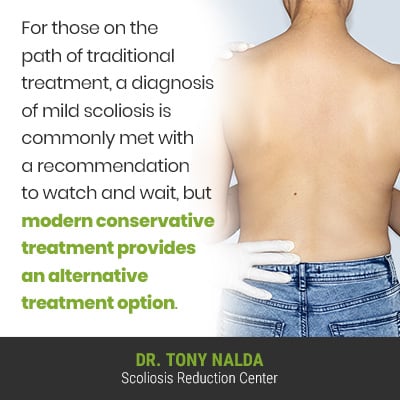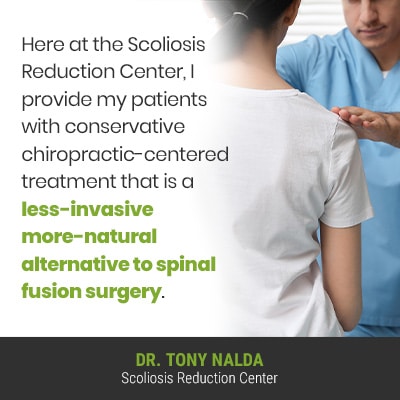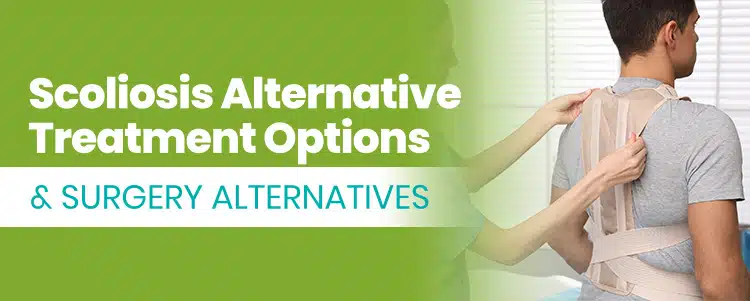As a progressive condition, scoliosis has it in its nature to worsen over time, and patients can choose between being proactive with treatment and working towards preventing progression, or taking a passive watch-and-wait approach, but this commonly funnels patients towards invasive scoliosis surgery.
The reality is that many cases of scoliosis don’t require surgery, but for those on the path of traditional treatment, spinal fusion can be the only option presented. Fortunately, scoliosis also responds to a conservative non-surgical treatment approach.
Let’s start our discussion on scoliosis alternative treatment by first exploring the condition’s progressive nature.
Scoliosis is a Progressive Condition
Progressive conditions have it in their nature to worsen over time, making them incurable and more complex to treat; in addition, the way a progressive condition is treated is particularly important because it won’t simply go away on its own.
While scoliosis is incurable, it can be highly treatable, but first, let’s address how a diagnosis of scoliosis is reached.
Scoliosis is diagnosed in people who have developed an unnatural sideways spinal curve, with rotation, which is what makes scoliosis a complex 3-dimensional condition.
In addition, a scoliotic curve has to be of a minimum size: a minimum Cobb angle measurement of at least 10 degrees.
A patient’s Cobb angle measurement is determined during X-ray by drawing lines from the tops and bottoms of the curve’s most-tilted vertebrae, and the resulting angle is expressed in degrees.
The higher a patient’s Cobb angle measurement, the more unnaturally tilted the vertebrae are at the curve’s apex, the further out of alignment the spine is, and the more severe the condition:
- Mild scoliosis: Cobb angle measurement of between 10 and 25 degrees
- Moderate scoliosis: Cobb angle measurement of between 25 and 40 degrees
- Severe scoliosis: Cobb angle measurement of 40+ degrees
- Very-severe scoliosis: Cobb angle measurement of 80+ degrees

The more severe a condition, the more likely it is that its effects are going to be noticeable, and the more complex it is to treat, which is why how a diagnosis is responded to is so important.
With progressive conditions like scoliosis, sometimes when treatment is started is almost as important as the type of treatment, and when it comes to scoliosis, the two main treatment approaches respond differently to a diagnosis.
And scoliosis doesn’t just range widely in severity, but also in the different types a person can develop: idiopathic scoliosis, neuromuscular scoliosis, degenerative scoliosis, and congenital scoliosis.
For those on the path of traditional treatment, a diagnosis of mild scoliosis is commonly met with a recommendation to watch and wait, but modern conservative treatment provides an alternative treatment option.
Scoliosis Alternative Treatment
Traditional scoliosis treatment was the dominant choice for many years, but that doesn’t mean it’s the best, nor only treatment option available.
If a patient’s scoliosis is diagnosed while mild and the diagnosis is met with proactive treatment, there are never guarantees, but there are generally fewer limits to what can be achieved.
Scoliosis surgery is a type of spinal fusion, and like all surgical procedures, it comes with its share or risks.
Spinal surgery, however, can be associated with some particularly serious potential risks, side effects, and complications.
Remember, the spinal cord works with the brain to form the central nervous system (CNS), and the central nervous system is a complex communication network that facilitates brain-body communication.
So nerve damage is a potential complication of spinal fusion, along with excessive blood loss, infection, and an adverse reaction to hardware used; spinal fusion involves fusing the curve’s most-tilted vertebrae into one solid bone to prevent movement (progression), and commonly, rods are attached to the spine with pedicle screws to hold it in place.
In addition to the risks associated with the procedure itself, there are the potential long-term effects of spinal fusion, and these are what patients really need to be aware of.
A fused spine is contrary to its natural movement-based design; a fused spine is not going to be as strong or flexible, and a reduced range of motion can impact a person’s overall quality of life.
For some people, they maintain enough spinal flexibility above and below the fused vertebrae to maintain a decent range of motion, but for many, this is the most disappointing result of scoliosis surgery.
In addition, a fused spine is not as strong or able to absorb and distribute mechanical stress during activity, so it is at an increased risk of injury, and this knowledge can have a psychological effect on patients who become fearful of trying new things, and/or participating in once-loved activities.
There is also a gap in the research on long-term effects of living with a fused spine 20, 30, 40+ years down the road, so we don’t yet fully understand all of the procedure’s potential effects.
For those who choose to forgo a surgical recommendation, or who simply want to try a less-invasive treatment option first, there are scoliosis surgery alternatives.
Best Alternative Treatment for Scoliosis

Here at the Scoliosis Reduction Center®, I provide my patients with conservative chiropractic-centered treatment that is a less-invasive more-natural alternative to spinal fusion surgery.
Being proactive with treatment means starting it as close to the time of diagnosis as possible, and while traditional treatment doesn’t have a strategy for treating scoliosis while mild, this is when treatment success is the most likely; scoliosis only gets more complex to treat, the more it progresses, because the spine gets increasingly rigid.
Increasing spinal rigidity makes the spine less responsive to treatment and can also make it difficult for some patients to perform certain therapeutic exercises as part of treatment.
The sooner treatment is started, the better, so the best time to start scoliosis treatment is always now because as a progressive condition, it’s virtually guaranteed to get worse, and it only gets harder to treat over time.
In addition, as scoliosis introduces a lot of uneven forces to the spine, its surrounding muscles and nerves, and the entire body, the effects increase alongside progression; in children, the main effect is postural deviation, and in adults, it’s pain.
The longer a condition is left to progress, the more established its effects are, and the more challenging they can be to reverse.
Conservative treatment integrates multiple different scoliosis-specific treatment disciplines so conditions can be impacted on every level, and this includes chiropractic care to work towards a curvature reduction, physical therapy to increase the strength of the spine’s surrounding supportive muscles, corrective bracing, and rehabilitation.
When it comes to treating a complex structural spinal condition like scoliosis, it needs to be impacted on every level, which is why no one treatment discipline on its own can correct a scoliosis, and the condition’s complex nature necessitates the customization of potentially-effective treatment plans.
Conclusion
While there can still be a place for surgical scoliosis treatment options, considering the risks involved, spinal fusion should be considered carefully.
If detected early in a condition’s progressive line, and if met with proactive treatment, scoliosis can be highly treatable, but patients need to be aware of all the treatment options available to them so they can make an informed choice.
With progressive conditions, how to manage their symptoms and effects is the challenge, and as scoliosis only gets more complex to treat the more it progresses, it makes sense to proactively work towards preventing progression, rather than trying to reverse the condition’s effects once they’re established.
When it comes to treating childhood scoliosis, patients who have not yet reached skeletal maturity are at risk for rapid-phase progression because growth is what triggers the condition to progress; adolescents are at the greatest risk for rapid progression because of the stage of puberty and its rapid and unpredictable growth spurts.
So when it comes to deciding on a treatment approach to commit to, making sure a patient’s expectations are aligned with the reality of its potential outcome is important because for those on the path of traditional treatment, surgery alternatives aren’t commonly presented.
So for patients who have been diagnosed with scoliosis and told that surgery is the best treatment option, being educated is important because that’s not always the case, and the reality is that many cases of scoliosis can be treated successfully without having to face the risk of an invasive surgical procedure.
Here at the Center, I believe that what’s best for my patients is for them to be treated with a proactive conservative treatment approach that works towards reducing the curve, while preserving as much of the spine’s natural strength and function as possible.




